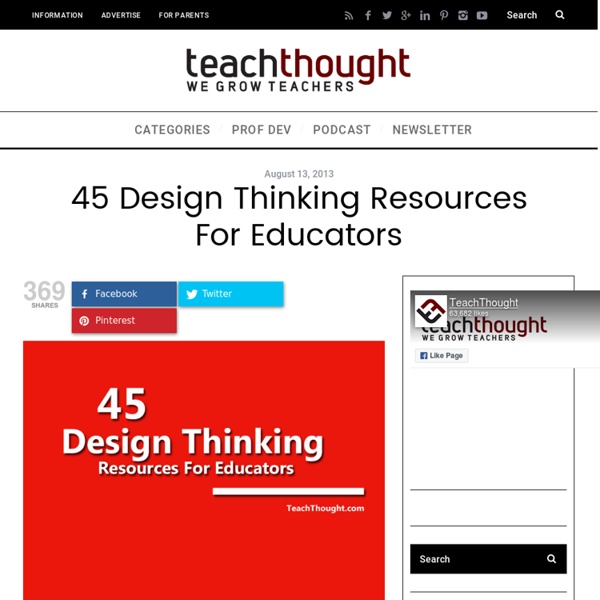10 Creative Geniuses Who Had to Fail to Succeed
Have you ever been told that you have to fail to succeed? That you should try to fail forward (whatever that means)? Or maybe the classic, “third time’s the charm?”
Use our methods
DP0 (Design Project Zero) is a 90-minute (including debrief) fast-paced project though a full design cycle. Students pair up to interview each other, create a point-of-view, ideate, and make a new solution that is “useful and meaningful” to their partner. Two versions of DP0 are “The Wallet Project” and “The Gift-Giving Project”. They have the similar format, only the topic is different. The original DP0 The Wallet Project was created for the d.school’s very first course in 2004 and the project starts with students looking at the content of their partner’s wallet or purse (and goes on to ask every student to design something for their partner). Another DP0 topic is The Gift-Giving Project where students are asked to redesign how their partner gives gifts.
Putting the World In Their Hands: Augmented Reality in the Classroom
Augmented reality at Avenues: The World Schools By Courtney Pepe When many of today’s teachers who grew up in Generation X are asked to reflect on traditional learning objects from their classrooms of the 1980’s and 1990’s, they think of paper, pencils, chalkboards, and textbooks. When they’re shown a series of pictures of those classroom’s from the ’70s, ’80s, and ’90s, and asked to describe them, they use adjectives like “utilitarian, boring, and two-dimensional.” The classrooms in which Millennials and Generation Z learn are a world apart from those of Baby Boomers and Generation X.
Why Making and the Arts Need Each Other to Survive and Thrive in Schools
When the visual and performing arts, the musical and recording arts, and the theatrical and graphical arts are seen as mere luxuries or add-ons within the walls of a school, powerful forces are thereby prevented from transforming routine schooling into a renaissance of learning. But who has the time or the funding to allow that to happen? Instead, let’s ask ourselves: How can these constraints compel us to leverage our creativity?
Leonardo Electronic Almanac – L.A. Re.Play Volume 21 No 1
L.A. Re.Play: Mobile Network Culture in Placemaking, Leonardo Electronic Almanac, Volume 21 Issue 1 ISBN: 978-1-906897-36-9 ISSN: 1071-4391 Date of Publication: January 15, 2016 Number of Pages: 244 Special Issue Editors: Lanfranco Aceti, Hana Iverson and Mimi Sheller Editorial Manager: Caglar Cetin The print issue of LEA Volume 21 Issue 1 L.A. Re.Play: Mobile Network Culture in Placemaking is available on Amazon.
The "New and Improved" Digital Citizenship Survival Kit
I have been thinking about some "new" items I could add to my original Digital Citizenship Kit that I created last year. Like I said in that blog post, I love using props when teaching. After some great conversations with the good wife @jenbadura on what I should include, I have come up with some new items to include in the survival kit. Yes, you can use this with your students! After I blogged about the original kit, I had a plethora of teachers email me or send me a tweet me asking if it was okay to use this idea at their school.
STEAM Point Giveaway
This is it! There’s only 1 day left before the launch of my new book, STEAM Point, and I’m so glad you tuned in. Today, we’re giving away two great pieces. The first is an assessment excerpt from the new book. This is our teacher’s guided rubric and it aligns to the Common Core Writing Standards, 6+1 Writing Traits, as well as UbD and STEM practices. It’s meant to provide teachers with a way to assess learning in multiple content areas.
Bridging the gap between art and code
"KNBC" by UCLA professor of digital media arts Casey Reas is an audio and visual distortion of television signals broadcast during December 2015. The signals were captured and archived at the artist's studio in Los Angeles. Turn up the sound as you watch this video that captures a few minutes of a continuous, generative collage. To UCLA visual artist Casey Reas, writing computer code and programming are not so much technical skills as “thinking” skills that he has managed to apply to artistic expression to great effect. “It’s a very interesting and powerful way of thinking that doesn’t have a specific domain,” Reas explained.
If You Want Creative Kids, Hand Them Something Simple
As Letícia, clad in a fluttering pink bridesmaid’s dress, walked to the center of the rose garden ahead of the bride, my 7-year-old reached his hand sideways, groping for my purse. He located his camera, held it up, and began snapping photos of his beloved babysitter in this beautiful setting. “I can show her later,” he said, putting down his dinged-up old Canon with the burned-out circle in the top left of the screen. “She might want to see.”



